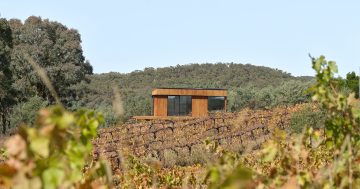By John Rozentals.
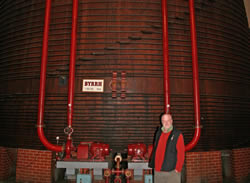
A lot of drinks: the author with the world’s largest oak wine vat.
The town of Thuir in southern France carries a huge, huge claim to fame. It reckons, with some justification, that it possesses the world’s largest — yes, you did read correctly, the world’s largest — oak wine vat.
Some 12-metres diameter at the base, 10-metres tall, weighing in at more than 1000 tonnes when full and holding a million plus 200 litres. That’s more than a whopping 1.3 million standard wine bottles — quite a headache in any language.
The vat took 15 years to construct over a period which included World War II, was made from staves 16cm thick and finally finished and brought to Thuir in 1951.
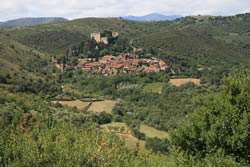
A vision splendid: the medieval castle and village of Castelnou.
It’s enough reason to visit the Caves Byhhr (pronounced ‘beerr’) in the prosperous town of Thuir, nestled in the lee of the Pyrenees Mountains, but more compelling reasons perhaps are provided by the history of the Violet family, which founded the cellars, and the creation during the nineteenth century of the bitterly refreshing Byrrh liqueur — built on a wine base and laced with secret ‘medicinal’ herbs — that eventually became part of the Pernod family of drinks.
Oh, and they did hire a French civil engineer by the name of Gustave Eiffel — yes, the one who designed that insignificant tower in Paris — to build a station hall for receiving goods trains.
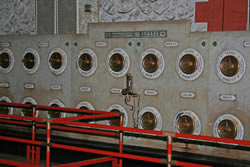
Now that’s a control centre: the still-beating heart of Caves Byrrh.
Byrrh liqueur had a highly regarded advertising campaign that proved, once again, that you can’t always sell what you’d like people to buy. There are plenty of examples of posters from the campaign displayed on the walls of the tasting room.
Visit www.caves-byrrh.fr for opening times and tour prices. The tour concludes with a tasting.
The town of Thuir is an historic one, best entered by the Perpignan gate, which is located opposite to tourist office and was the main point of entry to the original fortifications.
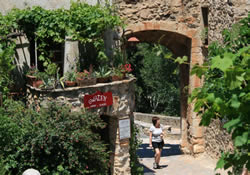
Take it home with you: one of Castelnou’s gorgeous laneways.
There are several attractions worth spending time over, apart from the famous cellars, including the town’s two perfectly preserved towers and the royal square, whose fountain was built in 1777 and originally supplied the whole town with drinking water.
Importantly, Thuir is the main access point — and just six kilometres or so away from — to the perfectly preserved medieval village of Castelnou, the approach to which provides one of those moments Australians dream of while spending all those hours in the air flying to Europe.
To come round a bend in the road and have the village appear in front of the car, unannounced, is splendidly sublime. I can fully understand the tyre ruts by the side of the road.

A poster exhorts the benefits of Byrrh: a highly regarded, but ultimately unsuccessful, ad campaign.
This village may share a name with major industrial cities in England and NSW, but that is absolutely where any similarity begins and stops.
It lies at the foot of a tenth-century feudal castle and its streets simply beg to be strolled, rolled up and brought home.
Spend a couple of hours wandering them, clamber the walls of the castle and take in a vista splendid, then just relax over a carafe of rosé and some lunch.
And do yourself the favour of not rolling a tour of the Byrrh cellars and a visit to Castelnou into the one day, or at least be prepared for a long and very involved, tiring day.
Just don’t, please don’t, leave this part of the world without devoting some time to its two main attractions — the world’s largest wine vat and a gorgeous medieval village.
Images: Sandra Burn White.



